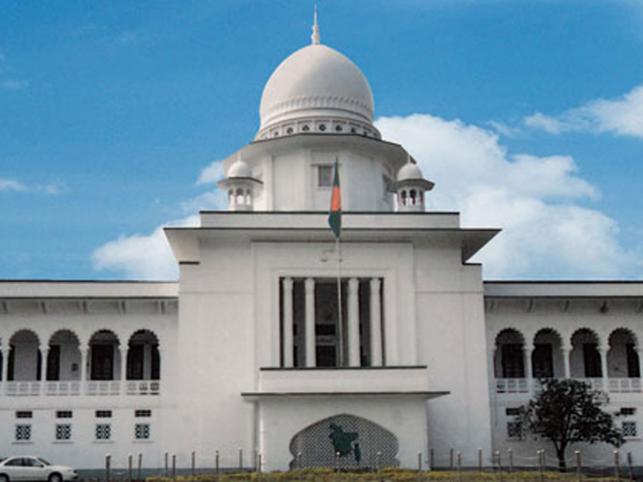The Appellate Division of the Supreme Court on Thursday released the full text of its verdict upholding a High Court order for bringing necessary reforms to the provisions of arrest without warrant and interrogation under the Code of Criminal Procedure.
The 396-page copy of the full text of the verdict signed by a four-member bench of the Appellate Division, headed by chief justice SK Sinha, was released in the SC website.
Apart from defining the responsibilities of the law enforcement agencies, the verdict also includes 19-point guidelines for the law enforcement and for the magistrates, judges and tribunals having power to take cognisance of an offence.
The SC also asked the inspector general of police (IGP) and the director general of the Rapid Action Battalion to issue a circular with the 19 guidelines for their respective units and all police stations across the country.
Hailing the verdict, senior jurist Shahdeen Malik while talking to newsmen has termed it a milestone towards the path of ensuring human rights.
Defining the responsibilities of the law enforcing agencies, the verdict said in the performance of their duty, law enforcement agencies shall respect and protect human dignity and maintain and uphold the human rights of all persons.
“Law enforcement agencies may use force only when strictly necessary and to the extent required for the performance of their duty… and the law enforcing agencies must not only respect but also protect the rights guaranteed to each citizen by the constitution,” read the verdict.
Guidelines for the law enforcement agencies:
(i) A law enforcement officer making the arrest of any person shall prepare a memorandum of arrest immediately after the arrest and such officer shall obtain the signature of the arrestee with the date and time of arrest in the said memorandum.
(ii) A law enforcement officer who arrests a person must intimate to a nearest relative of the arrestee and in the absence of his relative, to a friend to be suggested by the arrestee, as soon as practicable but not later than 12 (twelve) hours of such arrest notifying the time and place of arrest and the place in custody.
(iii) An entry must be made in the diary as to the ground of arrest and name of the person who informed the law enforcing officer to arrest the person or made the complaint along with his address and shall also disclose the names and particulars of the relative or the friend, as the case may be, to whom information is given about the arrest and the particulars of the law enforcing officer in whose custody the arrestee is staying.
(iv) Registration of a case against the arrested person is sine-qua-non for seeking the detention of the arrestee either to the law enforcing officer’s custody or in the judicial custody under section 167(2) of the Code.
(v) No law enforcing officer shall arrest a person under section 54 of the Code for the purpose of detaining him under section 3 of the Special Powers Act, 1974.
(vi) A law enforcing officer shall disclose his identity and if demanded, shall show his identity card to the person arrested and to the persons present at the time of arrest.
(vii) If the law enforcing officer find, any marks of injury on the person arrested, he shall record the reasons for such injury and shall take the person to the nearest hospital for treatment and shall obtain a certificate from the attending doctor.
(viii) If the person is not arrested from his residence or place of business, the law enforcing officer shall inform the nearest relation of the person in writing within 12 (twelve) hours of bringing the arrestee in the police station.
(ix) The law enforcing officer shall allow the person arrested to consult a lawyer of his choice if he so desires or to meet any of his nearest relation.
(x) When any person is produced before the nearest magistrate under section 61 of the Code, the law enforcing officer shall state in his forwarding letter under section 167(1) of the Code as to why the investigation cannot be completed within twenty four hours, why he considers that the accusation or the information against that person is well founded. He shall also transmit copy of the relevant entries in the case diary BP Form 38 to the magistrate.
Guidelines for the magistrates, judges and tribunals:
(a) If a person is produced by the law enforcing agency with a prayer for his detention in any custody, without producing a copy of the entries in the diary as per section 167(2) of the Code, the magistrate or the court, tribunal, as the case may be, shall release him in accordance with section 169 of the Code on taking a bond from him.
(b) If a law enforcing officer seeks an arrested person to be shown arrested in a particular case, who is already in custody, such magistrate or judge or tribunal shall not allow such prayer unless the accused/arrestee is produced before him with a copy of the entries in the diary relating to such case and if that the prayer for shown arrested is not well founded and baseless, he shall reject the prayer.
(c) On the fulfilment of the above conditions, if the investigation of the case cannot be concluded within 15 days of the detention of the arrested person as required under section 167(2) and if the case is exclusively triable by a court of sessions or tribunal, the magistrate may send such accused person on remand under section 344 of the Code for a term not exceeding 15 days at a time.
(d) If the magistrate is satisfied on consideration of the reasons stated in the forwarding letter and the case diary that the accusation or the information is well founded and that there are materials in the case diary for detaining the person in custody, the magistrate shall pass an order for further detention in such custody as he deems fit and proper, until legislative measure is taken as mentioned above.
(e) The magistrate shall not make an order of detention of a person in the judicial custody if the police forwarding report disclose that the arrest has been made for the purpose of putting the arrestee in the preventive detention.
(f) It shall be the duty of the magistrate/tribunal, before whom the accused person is produced, to satisfy that these requirements have been complied with before making any order relating to such accused person under section 167 of the Code.
(g) If the magistrate has reason to believe that any member of law enforcing agency or any officer who has legal authority to commit a person in confinement has acted contrary to law the magistrate shall proceed against such officer under section 220 of the Penal Code.
(h) Whenever a law enforcing officer takes an accused person in his custody on remand, it is his responsibility to produce such accused person in court upon expiry of the period of remand and if it is found from the police report or otherwise that the arrested person is dead, the magistrate shall direct for the examination of the victim by a medical board, and in the event of burial of the victim, he shall direct exhumation of the dead body for fresh medical examination by a medical board, and if the report of the board reveals that the death is homicidal in nature, he shall take cognizance of the offence punishable under section 15 of Hefajate Mrittu (Nibaran) Ain, 2013 against such officer and the officer in-charge of the respective police station or commanding officer of such officer in whose custody the death of the accused person took place.
(i) If there are materials or information to a magistrate that a person has been subjected to ‘Nirjatan’ or died in custody within the meaning of section 2 of the Nirjatan and Hefajate Mrittu (Nibaran) Ain, 2013, shall refer the victim to the nearest doctor in case of ‘Nirjatan’ and to a medical board in case of death for ascertaining the injury or the cause of death, as the case may be, and if the medical evidence reveals that the person detained has been tortured or died due to torture, the magistrate shall take cognisance of the offence suo-moto under section 190(1)(c) of the Code without awaiting the filing of a case under sections 4 and 5 and proceed in accordance with law.
Source: Prothom Alo










